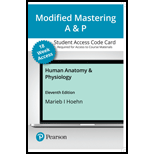
HUMAN ANATOMY + PHYSIOLOGY + MAST AP
11th Edition
ISBN: 9780136782056
Author: Marieb
Publisher: INTER PEAR
expand_more
expand_more
format_list_bulleted
Question
Chapter 15, Problem 5CCS
Summary Introduction
Introduction:
Brian Rhen was a 42-year-old male and had been experiencing recurring episodes of vertigo. He was later on referred to a neurologist. He was diagnosed with the condition known as benign paroxysmal positional vertigo. The cause of this condition is head trauma and vertigo can be provoked by the particular alterations in the head positions.
Expert Solution & Answer
Want to see the full answer?
Check out a sample textbook solution
Students have asked these similar questions
The Sentinel Cell: Nature’s Answer to Cancer?
Molecular Biology Question
You are working to characterize a novel protein in mice. Analysis shows that high levels of the primary transcript that codes for this protein are found in tissue from the brain, muscle, liver, and pancreas. However, an antibody that recognizes the C-terminal portion of the protein indicates that the protein is present in brain, muscle, and liver, but not in the pancreas. What is the most likely explanation for this result?
Molecular Biology
Explain/discuss how “slow stop” and “quick/fast stop” mutants wereused to identify different protein involved in DNA replication in E. coli.
Chapter 15 Solutions
HUMAN ANATOMY + PHYSIOLOGY + MAST AP
Ch. 15 - Prob. 1RQCh. 15 - 2. The portion of the fibrous layer that is white...Ch. 15 - 3. Which sequence best describes a normal route...Ch. 15 - 5. Damage to the medial recti muscles would...Ch. 15 - 6. The phenomenon of dark adaptation is best...Ch. 15 - Prob. 18RQCh. 15 - Prob. 5RQCh. 15 - Prob. 6RQCh. 15 - Prob. 7RQCh. 15 - Prob. 8RQ
Ch. 15 - 14. Taste buds are found on the (a) anterior part...Ch. 15 - 17. Olfactory nerve filaments are found (a) in the...Ch. 15 - Prob. 11RQCh. 15 - 20. Which of the following statements does not...Ch. 15 - Prob. 19RQCh. 15 - Prob. 13RQCh. 15 - Prob. 20RQCh. 15 - Prob. 21RQCh. 15 - Prob. 14RQCh. 15 - 28. Why do you often have to blow your nose after...Ch. 15 - 29. How do rods and cones differ functionally?
Ch. 15 - Prob. 25RQCh. 15 - Prob. 26RQCh. 15 - Prob. 23RQCh. 15 - Name the cranial nerves that serve the sense of...Ch. 15 - Prob. 27RQCh. 15 - Prob. 28RQCh. 15 - Prob. 29RQCh. 15 - Prob. 30RQCh. 15 - Prob. 24RQCh. 15 - Prob. 31RQCh. 15 - Prob. 32RQCh. 15 - Prob. 1CCSCh. 15 - Prob. 2CCSCh. 15 - Prob. 3CCSCh. 15 - Prob. 4CCSCh. 15 - Prob. 5CCSCh. 15 - Prob. 6CCS
Knowledge Booster
Similar questions
- Molecular Biology Question A gene that codes for a protein was removed from a eukaryotic cell and inserted into a prokaryotic cell. Although the gene was successfully transcribed and translated, it produced a different protein than it produced in the eukaryotic cell. What is the most likely explanation?arrow_forwardMolecular Biology LIST three characteristics of origins of replicationarrow_forwardMolecular Biology Question Please help. Thank you For E coli DNA polymerase III, give the structure and function of the b-clamp sub-complex. Describe how the structure of this sub-complex is important for it’s function.arrow_forward
- Molecular Biology LIST three characteristics of DNA Polymerasesarrow_forwardMolecular Biology RNA polymerase core enzyme structure contains what subunits? To form holo enzyme, sigma factor is added to core. What is the name of the structure formed? Give the detailed structure of sigma factor and the function of eachdomain. Please help. Thank youarrow_forwardMolecular Biology You have a single bacterial cell whose DNA is labelled with radioactiveC14. After 5 rounds of cell division, how may cells will contain radioactive DNA? Please help. Thank youarrow_forward
- 1. Explain the structure and properties of atoms and chemical bonds (especially how they relate to DNA and proteins). Also add some pictures.arrow_forward1. In the Sentinel Cell DNA integrity is preserved through nanoscopic helicase-coordinated repair, while lipids in the membrane are fortified to resist environmental mutagens. also provide pictures for this question.arrow_forwardExplain the structure and properties of atoms and chemical bonds (especially how they relate to DNA and proteins). Also add some pictures.arrow_forward
- In the Sentinel Cell DNA integrity is preserved through nanoscopic helicase-coordinated repair, while lipids in the membrane are fortified to resist environmental mutagens. also provide pictures for this question.arrow_forward1. Explain how genetic information is stored, copied, transferred, and expressed. Also add some pictures for this question.arrow_forward!. Describe biological macromolecules (DNA, RNA, proteins, lipids, etc.) and how they function in the cell. also provide some images for this question.arrow_forward
arrow_back_ios
SEE MORE QUESTIONS
arrow_forward_ios
Recommended textbooks for you
 Medical Terminology for Health Professions, Spira...Health & NutritionISBN:9781305634350Author:Ann Ehrlich, Carol L. Schroeder, Laura Ehrlich, Katrina A. SchroederPublisher:Cengage Learning
Medical Terminology for Health Professions, Spira...Health & NutritionISBN:9781305634350Author:Ann Ehrlich, Carol L. Schroeder, Laura Ehrlich, Katrina A. SchroederPublisher:Cengage Learning Human Biology (MindTap Course List)BiologyISBN:9781305112100Author:Cecie Starr, Beverly McMillanPublisher:Cengage LearningEssentials of Pharmacology for Health ProfessionsNursingISBN:9781305441620Author:WOODROWPublisher:Cengage
Human Biology (MindTap Course List)BiologyISBN:9781305112100Author:Cecie Starr, Beverly McMillanPublisher:Cengage LearningEssentials of Pharmacology for Health ProfessionsNursingISBN:9781305441620Author:WOODROWPublisher:Cengage

Medical Terminology for Health Professions, Spira...
Health & Nutrition
ISBN:9781305634350
Author:Ann Ehrlich, Carol L. Schroeder, Laura Ehrlich, Katrina A. Schroeder
Publisher:Cengage Learning



Human Biology (MindTap Course List)
Biology
ISBN:9781305112100
Author:Cecie Starr, Beverly McMillan
Publisher:Cengage Learning


Essentials of Pharmacology for Health Professions
Nursing
ISBN:9781305441620
Author:WOODROW
Publisher:Cengage